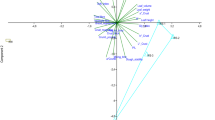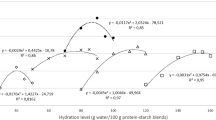Abstract
The significance of grain (chickpea, pea) and oilseed (soybean) legumes on the nutritional and functional added value of wheat breads was assessed in composite matrices (from 18 to 54% of wheat flour replacement). Gluten (from 1 to 5% of wheat flour replacement) and carboxymethylcellulose (from 1 to 5% of wheat flour replacement) were used as structuring agents. The study allowed the identification of the qualitative (chickpea and pea) and quantitative legumes (up to 42% of wheat flour replacement), providing enhancement of nutritional value of sensorially accepted breads. Associated mixtures of legumes-wheat-structuring agents (42:52:6) have proven to make highly nutritious breads in terms of promoted dietary fibre fractions, lower and slower starch hydrolysis, decreased rapidly digestible starch and reduced expected glycaemic index. In addition, viscoelastic restrictions and sensory standards are met.

Similar content being viewed by others
References
Tharanathan RN, Mahadevamma S (2003) Grain legumes-a boon to human nutrition. Trends Food Sci Technol 14:507–518
Guillon F, Champ MMJ (2002) Carbohydrate fractions of legumes: uses in human nutrition and potential for health. Br J Nutr 88:S293–S306
Patterson CA, Maskus H, Bassett CMC (2010) Fortifying foods with pulses. Cereal Foods World 55(2):56–62
Jones JM (2009) Nutrition: more on the GI debate. Cereal Foods World 54(3):138–140
Serrem CA, Kock HL, Taylor JRN (2011) Nutritional quality, sensory quality and consumer acceptability of sorghum and bread wheat biscuits fortified with defatted soy flour. Int J Food Sci Technol 46(1):74–83
Jayasena V, Leung P, Nasar-Abbas SM (2008) Lupins for health and wealth. In: Palta JA, Berger JB (eds) Proceedings of the 12th international lupin conference, pp 473–477
Gómez M, Oliete B, Rosell CM, Pando V, Fernández E (2008) Studies on cake quality made of wheat-chickpea flour blends. LWT Food Sci Technol 41:1701–1709
Singh N, Harinder K, Sekhon KS, Kaur B (1991) Studies on the improvement of functional and baking properties of wheat-chickpea flour blends. J Food Process Pres 15:391–402
Yamsaengsung R, Schoenlechner R, Berghofer E (2010) The effects of chickpea on the functional properties of white and whole wheat bread. Int J Food Sci Technol 45:610–620
Utrilla-Coello RG, Osorio-Díaz P, Bello-Pérez LA (2007) Alternative use of chickpea flour in breadmaking: chemical composition and starch digestibility of bread. Food Sci Tech Int 13(4):323–327
Indrani D, Swetha P, Soumya C, Rajiv J, Venkateswara Rao G (2011) Effect of multigrains on rheological, microstructural and quality characteristics of north Indian parotta—an Indian flat bread. LWT Food Sci Technol 44(3):719–724
ICC Standard Methods of the International Association for Cereal Chemistry (1976–1996) 104/1, 105/2, 110/1, 115/1, 136, 162. The Association: Vienna
Association of Official Analytical Chemists (AOAC) (1991) Total, soluble, and insoluble dietary fiber in foods
Collar C (2003) Significance of viscosity profile of pasted and gelled formulated wheat doughs on bread staling. Eur Food Res Technol 216:505–513
Collar C, Andreu P, Martínez JC, Armero E (1999) Optimization of hydrocolloid addition to improve wheat bread dough functionality: a response surface methodology study. Food Hydrocoll 13:467–475
Ramirez-Jimenez A, Garcia-Villanova B, Guerra-Hernandez E (2001) Effect of toasting time on the browning of sliced bread. J Sci Food Agric 81(5):513–518
Hsu CL, Chen W, Weng YM, Tseng CY (2003) Chemical composition, physical properties, and antioxidant activities of yam flours as affected by different drying methods. Food Chem 83:85–89
Angioloni A, Collar C (2009) Bread crumb quality assessment: a plural physical approach. Eur Food Res Technol 229:21–30
AACC (2000) Approved methods of the American Association of Cereal Chemists, 10th edn. AACC, St Paul
Englyst KN, Vinory S, Englyst HN, Lang V (2003) Glycaemic index of cereal products explained by their content of rapidly and slowly available glucose. Brit J Nutr 89:329–339
Chung HJ, Liu Q, Hoover R, Warkentin TD, Vandenberg B (2008) In vitro starch digestibility, expected glycemic index, and thermal and pasting properties of flours from pea, lentil and chickpea cultivars. Food Chem 111:316–321
Goñi I, Garcia-Alonso A, Saura-Calixto F (1997) A starch hydrolysis procedure to estimate glycemic index. Nutr Res 17:427–437
Angioloni A, Collar C (2011) Physicochemical and nutritional properties of reduced-caloric density high-fibre breads. LWT Food Sci Technol 44:747–758
Angioloni A, Collar C (2011) Nutritional and functional added value of oat, Kamut®, spelt, rye and buckwheat versus common wheat in breadmaking. J Sci Food Agric 91:1283–1292
Granfeldt Y, Björck I, Drews A, Tovar J (1992) An in vitro procedure based on chewing to predict metabolic responses to starch in cereal and legume products. Eur J Clin Nutr 46:649–660
Saura-Calixto F, García-Alonso A, Goñi I, Bravo L (2000) In vitro determination of the indigestible fraction in foods: an alternative to dietary fiber analysis. J Agric Food Chem 48:3342–3347
Singleton VL, Orthofer R, Lamuela-Raventós RM (1999) Analysis of total phenols and other oxidation substrates and antioxidants by means of folineciocalteu reagent. Methods Enzymol 299:152–178
Brand-Williams W, Cuvelier BersetC (1995) Use of a free radical method to evaluate antioxidant activity. Food Sci Technol 28:25–30
Sánchez-Moreno C, Larrauri JA, Saura-Calixto F (1998) A procedure to measure the antiradical efficiency of polyphenols. J Sci Food Agric 76:270–276
Angioloni A, Collar C (2009) Small and large deformation viscoelastic behaviour of selected fibre blends with gelling properties. Food Hydrocoll 23:742–748
Lodi A, Vodovotz Y (2008) Physical properties and water state changes during storage in soy bread with and without almond. Food Chem 11:554–561
European Commission (2006) Nutrition and health claims made in foods. Off J Eur Comm L 404:9–25
Dietary Reference Intakes for Energy, Carbohydrate, Fiber, Fat, Fatty Acids, Cholesterol, Protein, and Amino Acids (2002/2005) www.nap.edu
FAO/WHO (1997) Recommendations. Joint FAO/WHO expert consultation on carbohydrates in human nutrition. Rome
Pérez-Jiménez J, Arranz S, Tabernero M, Dìaz-Rubio ME, Serrano J, Goñi I, Saura-Calixto F (2008) Updated methodology to determine antioxidant capacity in plant foods, oils and beverages: extraction, measurement and expression of results. Food Res Int 41:274–285
Foti MC, Dasquino C, Geraci C (2004) Electron-transfer reaction of cinnamic acids and their methyl esters with the DPPH radical in alcohol solutions. J Org Chem 69:2309–2314
Amarowicz R, Pegg RB (2008) Legumes as a source of natural antioxidants. Eur J Lipid Sci Technol 110:865–878
Xu B, Chang SKC (2008) Total phenolics, phenolic acids, isoflavones, and anthocyanins and antioxidant properties of yellow and black soybeans as affected by thermal processing. J Agric Food Chem 56:7165–7175
FAO (2002) Food energy—methods of analysis and conversion factors. FAO Food and Nutrition Paper, 77. ISSN 0254-4725
Acknowledgments
The authors acknowledge the financial support of the Spanish institutions Consejo Superior de Investigaciones Científicas (CSIC) (Postdoctoral JAE contract) and Ministerio de Ciencia e Innovación (Project AGL2011-22669).
Author information
Authors and Affiliations
Corresponding author
Rights and permissions
About this article
Cite this article
Angioloni, A., Collar, C. High legume-wheat matrices: an alternative to promote bread nutritional value meeting dough viscoelastic restrictions. Eur Food Res Technol 234, 273–284 (2012). https://doi.org/10.1007/s00217-011-1637-z
Received:
Revised:
Accepted:
Published:
Issue Date:
DOI: https://doi.org/10.1007/s00217-011-1637-z




